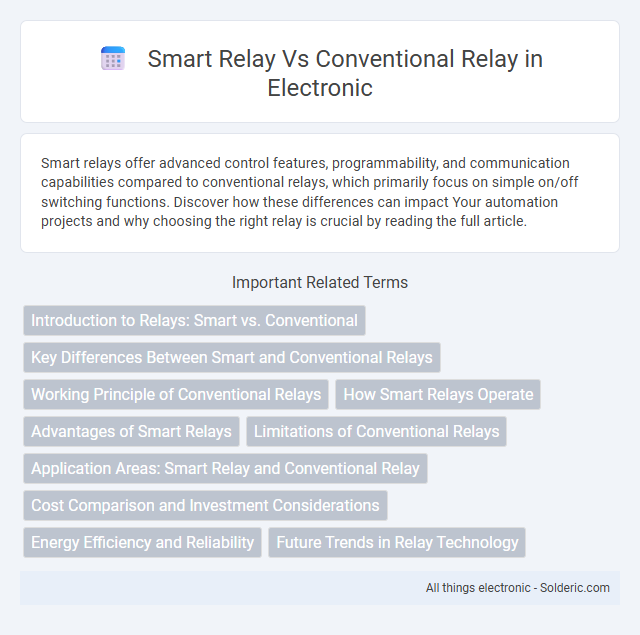Smart relays offer advanced control features, programmability, and communication capabilities compared to conventional relays, which primarily focus on simple on/off switching functions. Discover how these differences can impact Your automation projects and why choosing the right relay is crucial by reading the full article.
Comparison Table
| Feature | Smart Relay | Conventional Relay |
|---|---|---|
| Functionality | Programmable logic control, automation | Simple on/off electrical switching |
| Control | Digital, remote, and network-enabled control | Manual or basic electrical control |
| Integration | Supports IoT and smart systems integration | Limited to standalone operation |
| Diagnostics | Built-in diagnostics and status monitoring | No self-diagnostics |
| Flexibility | Reconfigurable logic and functions | Fixed mechanical operation |
| Installation | Requires programming and setup | Simple wiring, plug-and-play |
| Cost | Higher initial cost, cost-effective for complex tasks | Lower initial cost, suitable for basic switching |
| Applications | Industrial automation, smart buildings, complex control systems | Basic electrical circuits, lighting, simple load control |
Introduction to Relays: Smart vs. Conventional
Smart relays offer advanced control capabilities, programmable logic functions, and real-time monitoring, whereas conventional relays primarily provide simple on/off switching based on electromagnetic mechanisms. Your automation system benefits from smart relays' enhanced flexibility, integration with digital networks, and diagnostic features that improve efficiency and reduce downtime. Conventional relays remain reliable for basic applications but lack the adaptability and intelligence of smart relay technology.
Key Differences Between Smart and Conventional Relays
Smart relays feature integrated microprocessors that enable programmable logic control, advanced diagnostics, and remote monitoring, unlike conventional relays which operate solely through electromagnetic switching. Conventional relays require manual wiring and physical adjustments, while smart relays offer customizable configurations via software interfaces, enhancing flexibility and efficiency. Your automation system benefits from smart relays' real-time data processing and communication capabilities, leading to improved system reliability and easier maintenance.
Working Principle of Conventional Relays
Conventional relays operate using an electromagnetic coil that generates a magnetic field when energized, causing a movable armature to either open or close electrical contacts. This mechanical switching enables control of high-power circuits through a low-power signal without direct electrical connection. The fundamental working principle relies on electromagnetic induction and mechanical movement to achieve circuit isolation and switching.
How Smart Relays Operate
Smart relays operate using integrated microprocessors that allow for programmable control, enabling customization of automation sequences and real-time diagnostics. Unlike conventional relays which function based on simple electromagnetic switching mechanisms, smart relays can communicate with other devices and adjust operations based on sensor inputs. By utilizing your smart relay, you gain enhanced flexibility and efficiency in managing complex industrial or home automation systems.
Advantages of Smart Relays
Smart relays offer advanced programmability, enabling customized automation solutions that enhance operational efficiency compared to conventional relays. Their integrated diagnostic features reduce downtime by quickly identifying faults and facilitating predictive maintenance. You benefit from improved flexibility and scalability in control systems, making smart relays ideal for modern industrial applications.
Limitations of Conventional Relays
Conventional relays are limited by their mechanical components, resulting in slower switching speeds and increased wear over time, which reduces reliability in high-frequency applications. They often lack advanced diagnostic features and real-time monitoring capabilities, making fault detection and maintenance more challenging. The absence of programmable logic restricts their flexibility, limiting adaptability in complex control systems compared to smart relays.
Application Areas: Smart Relay and Conventional Relay
Smart relays are widely used in industrial automation, building management systems, and complex machinery control where programmable logic and remote monitoring are essential. Conventional relays find common applications in basic electrical circuits, motor starters, and simple switching tasks due to their reliability and straightforward operation. The choice between smart and conventional relays depends on the complexity of control requirements and the need for flexibility and integration with digital systems.
Cost Comparison and Investment Considerations
Smart relays typically have a higher initial cost compared to conventional relays due to advanced features like programmability and integrated diagnostics. However, Your long-term investment benefits from reduced wiring, easier maintenance, and enhanced system flexibility, which can lower overall operational expenses. Evaluating the total cost of ownership, including installation, programming, and lifecycle support, is essential when choosing between smart and conventional relays.
Energy Efficiency and Reliability
Smart relays offer superior energy efficiency compared to conventional relays by minimizing power consumption through integrated microprocessors and optimized switching mechanisms. Their enhanced reliability stems from advanced diagnostic features and real-time monitoring, which reduce failure rates and maintenance downtime. Conventional relays, relying on mechanical components, tend to consume more energy and exhibit higher wear, limiting their operational lifespan and consistency.
Future Trends in Relay Technology
Smart relays are rapidly transforming the future of relay technology by integrating IoT capabilities, enabling remote monitoring, diagnostics, and predictive maintenance, which significantly enhance operational efficiency compared to conventional relays. Conventional relays, while reliable and cost-effective, lack the advanced data processing and communication functions that smart relays offer, making them less adaptable to Industry 4.0 environments. Your automation systems will benefit from adopting smart relays as they support real-time data analytics and seamless integration with smart grids and automated control systems, driving innovations in energy management and industrial automation.
Smart relay vs conventional relay Infographic

 solderic.com
solderic.com